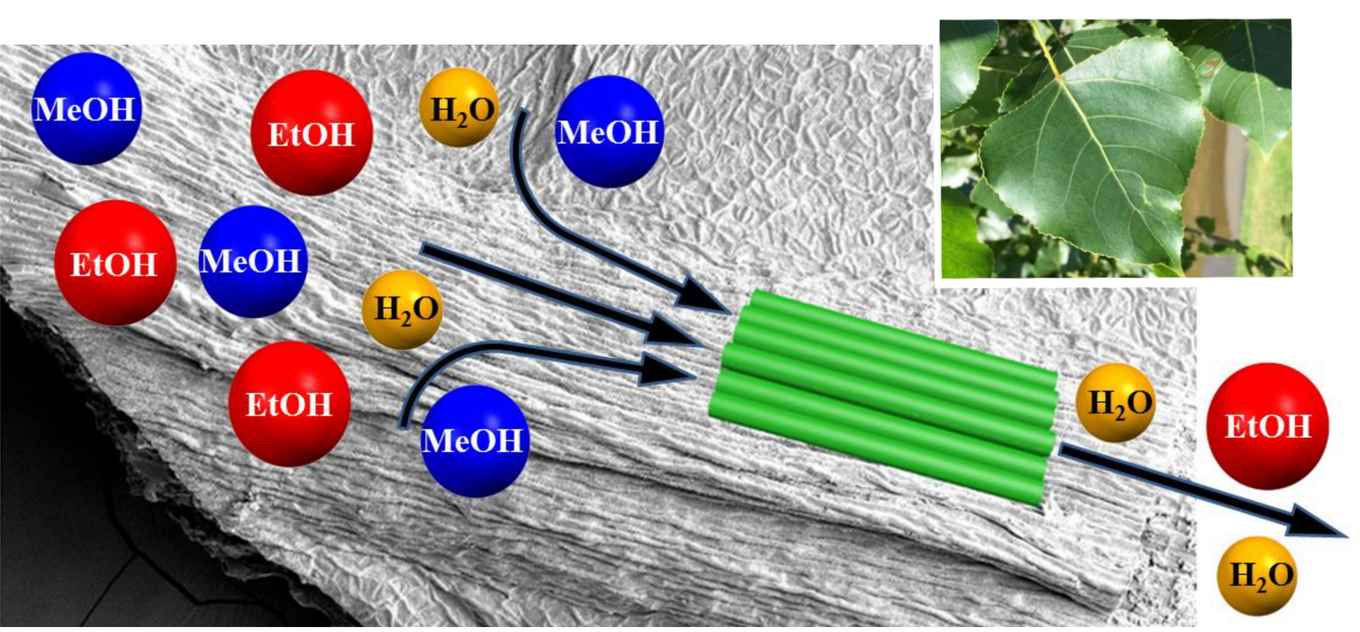Looking at leaves: enhancing the performance of MOF materials
Amsterdam chemists present bio-inspired design of adsorbent materials for selective separation of water and alcohol
26 June 2019

Separation of water-alcohol mixtures is one of the most challenging problems associated with the practical application of bioethanol as a sustainable fuel. Produced from agricultural feedstocks, algae farms or the fermentation of molasses, bioethanol contains both water and methanol as impurities. Obtaining fuel-grade bioethanol from these water-alcohol mixtures using traditional distillation is not practical because water and ethanol form a so-called azeotropic mixture.
The cost-effective and green alternative to distillation is adsorptive separation. In biofuels production, this method relies on the development of adsorbent materials which are highly selective towards ethanol or the impurities in the mixture. At the University of Amsterdam’s Research Priority Area Sustainable Chemistry, the group of Dr Stefania Grecea develops synthetic approaches for designing porous molecular-based materials with such selective adsorption properties.
Adsorbent Materials
Suitable adsorbent materials for separation applications should have an appropriate porous structure and high specific surface area to facilitate both the adsorption and diffusion of specific molecules. A specific class of adsorbent materials are Metal-Organic Frameworks (MOFs). They have a high specific area and by tuning the size and functionality of their pores at the molecular level, specific adsorption selectivities can be achieved.
However, practical application also depends on their macroscopic properties. Often MOFs are synthesized as powders of tiny crystals. These cannot be used directly in industrial applications because they have limited packing density as well as high diffusion barriers. A solution is to shape MOFs as granules, pellets or monoliths, or to disperse them within thin films, creating membranes. However, the pressure applied in such shaping methods leads to loss of crystallinity and therefore to reduced activity or even inactivation of the MOF materials. It is therefore still quite a challenge to find the most appropriate processing method of MOFs.
Looking at leaves
In search for ways to improve MOF performance, the Amsterdam researchers turned to Nature. In particular, to green plant leaves. Scientists have already used natural leaves as templates to design heterogeneous photocatalysts, as they are structured to provide efficient light harvesting. Such artificial leaf structures have proven to be very effective for hydrogen production.
The UvA researchers took their inspiration from the natural leaf vein system that has evolved for transporting aqueous liquids. It is a hierarchical porous system consisting of many fibres and vessels of different sizes. In separation technology, hierarchically porous materials having multi-level pores often present enhanced adsorption performance compared to uniformly-sized porous materials.
Therefore, the researchers synthesized a mixed-metal oxide material with a hierarchical porous structure using a sol-gel method in which natural leaves of the black poplar (Populous nigra) were used as a template. This mixed-oxide artificial leaf was then used as a support for creating a homogeneously dispersed layer of MOF crystals.
Detailed morphological studies showed that the resulting composite material indeed has a hierarchical porous structure and that MOF crystals with narrow size distribution are homogenously dispersed at the inner surface of the hierarchical pores.
Performance studies
In the light of application in bioethanol purification, Yiwen Tang studied the water, methanol and ethanol adsorption properties of the new material. He established that the selectivity varies in the order methanol > ethanol > water. Subsequent molecular simulations performed by Dr David Dubbeldam using equimolar ethanol-methanol mixtures showed that methanol adsorption is highly selectively in the low-pressure range. Moreover, the material is effective in separating water-ethanol mixtures with ethanol being adsorbed selectively in the low-pressure range, whilst water is adsorbed selectively at high pressures.
The researchers conclude that their bio-inspired synthetic approach is highly relevant not only for molecular separations applications but also as a general strategy for designing MOF composite materials for various applications, including catalysis and molecular sensing.
The collaboration was actively supported by the Research Priority Area Sustainable Chemistry, and the Chinese Scientific Council (through a CSC PhD fellowship to Yiwen Tang).
Publication details
Yiwen Tang, David Dubbeldam, Xingmei Guo, Gadi Rothenberg, Stefania Tanase: Efficient Separation of Ethanol–Methanol and Ethanol–Water Mixtures Using ZIF-8 Supported on a Hierarchical Porous Mixed-Oxide Substrate. ACS Appl. Mater. Interfaces 2019, 11, 23, 21126-21136. DOI: 10.1021/acsami.9b02325.
Links
UvA Research Priority Area Sustainable Chemistry